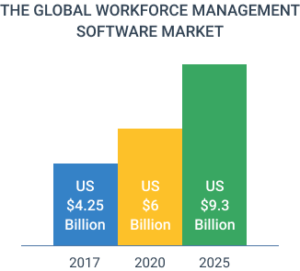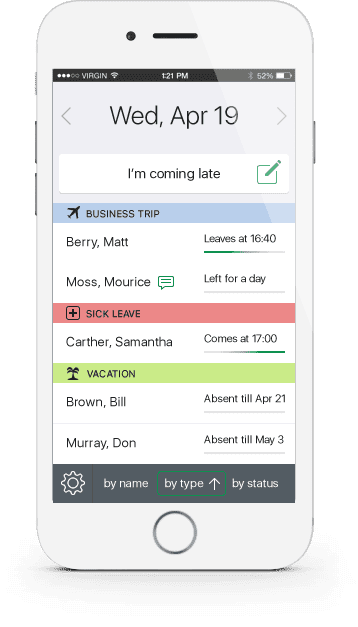Employee attendance is undergoing significant changes. Various factors, such as adopting remote and hybrid work models, absence-tracking technology advancements, promotion of flexible schedules, etc. urge businesses to implement more and more strategies that promote a healthy and engaged workforce.
In this article, we will discuss the significant attendance trends and statistics shaping the future of absence tracking: from software and technology to social and cultural dynamics.
What Employee Attendance Trends Are and How You Can Benefit from Them
Employee absence trends are the patterns or recurring behaviors related to employee leaves. These trends can be determined through the analysis of absence data over a specific period.
Analyzing absence trends can help your business in several ways:
1. Resource planning. You can anticipate employee availability and plan resources by analyzing absence trends and thus, avoid understaffing or overstaffing situations, ensuring optimal productivity.
2. Identifying patterns. Analyzing absence trends helps identify any recurring patterns or spikes in absences. This information can be used to address underlying issues, such as employee burnout, low morale, or health concerns, and take preventive measures.
3. Cost control. By analyzing absence trends, you can assess the financial implications of absenteeism and develop strategies to minimize costs associated with unplanned absences.
4. Productivity and performance. Consistent absence monitoring allows you to identify the impact of absenteeism on productivity and performance. It helps understand the relationship between attendance patterns and work outcomes, enabling targeted interventions for improvement.
5. Employee engagement and well-being. Analyzing absence trends provides insights into employee engagement and well-being. It helps identify factors affecting attendance, such as work-related stress, dissatisfaction, or personal issues. This information can guide efforts to enhance employee well-being and create a supportive work environment.
Overall, monitoring absence trends can help you take appropriate measures and minimize their impact on productivity, employee morale, and performance.
Five Employee Attendance Trends to Keep an Eye on Today and Further
Absenteeism Growth
According to the U.S. Bureau of Labour Statistics, the number of workers who had an illness-related absence from work doubled between 2021 and 2022 and continues to grow. If we add burnout, stress, disengagement, and harassment to already considered illnesses, injuries, and mental health issues, we may come up with overwhelming numbers.
In monetary figures, absenteeism costs millions of dollars and pounds in the US and UK.
Trend drivers: There can be several reasons behind absenteeism growth; here are just some of them:
- The COVID-19 pandemic and its aftermath. Employees may need time off for illness, quarantine, or caregiving responsibilities. Concerns about health and safety could also lead to more frequent absences.
- Increased stress, anxiety, and burnout that lead to higher levels of absenteeism as employees take time off to address their mental well-being.
- Work-Life Balance Issues. Blurring boundaries between work and personal life due to remote work or flexible schedules can make it challenging for employees to avoid overwork.
- Increased workload, lack of job satisfaction, limited growth opportunities, or poor work-life balance can force employees to take time off to cope with stress or disengagement from their work.
How to respond to the trend: It’s essential for organizations to address the factors above and create a supportive work environment. Organizations can mitigate absenteeism and improve employee engagement and productivity by promoting employee well-being and providing resources for mental health support.
Further reading: What Causes Absenteeism and How to Deal With It Efficiently?
Time- and Attendance-Tracking Software Proliferation
Absence tracking forms a part of the global workforce management software market. According to a recent report by MarketsandMarkets, in combination with other core market segments – scheduling, attendance monitoring, time, and HR management – it is now valued at US $6 billion.
As per the data provided by PR Newswire, the market had a total value of about US $4.25 billion in 2017, which indicates that, over the previous years, it has been growing at a relatively moderate pace.

Trend drivers: We have all the reasons to believe that absence trackers will be getting more technologically advanced and innovative, and two main factors contribute to that.
- Intense competition. A low concentration rate now characterizes the workforce management market. It means that although some industry players, such as Kronos or Bitrix24, are more popular among consumers than others, new entrants still have plenty of opportunities to build scale and capture a significant market share.
That said, the competition level between software companies in different market segments is high. Companies must create more customer values to outperform rivals and develop unique, high-quality products.
- Technological progress. Digitalization remains one of the primary workplace trends these days. Automation, AI, cloud computing, and other innovations are redefining our approach to business management.
Meanwhile, traditional paper-and-pencil and manual-entry tools are turning hopelessly obsolete and are being replaced by cloud technology offering solutions that are accurate, flexible, and accessible.
These systems allow employees to change their work statuses from any location, whether they are in the office or working remotely.
How to respond to the trend: Don’t wait for the future to invest in an intelligent attendance tracking tool – make leave management more efficient and introduce greater transparency and flexibility into the process by using a high-quality absence tracker today!
actiPLANS is a perfect example of an intelligent solution for attendance that supports a flexible approach to employee scheduling.
It allows users to plan their preferred work time and leave periods in advance or make immediate changes to personal timetables whenever such a need arises.
actiPLANS promptly notifies managers about employee schedule modifications and PTO requests while enabling them to automate the request approval process for a simplified absence management workflow.
The tool also integrates with actiTIME, a powerful time tracker allowing you to combine attendance monitoring, timesheet management, payroll, and employee productivity analytics into a single ecosystem.
actiPLANS is a perfect example of a smart instrument for leave management that supports a flexible approach to employee scheduling. It allows users to plan the preferred work time and leave periods in advance or make immediate changes to personal timetables whenever such a need arises.
actiPLANS promptly notifies managers about schedule modifications and employee leave requests, while also enabling them to automate the request approval process for a simplified absence management workflow.

Further reading: HR Benefits of a Hi-Tech Approach to Absence Management
Remote and Flexible Work Arrangements
Numerous studies have repeatedly shown that flexibility and mobility are two of the primary values of Millennials, who will constitute 75% of the global workforce by 2025.
Trend drivers: Younger people are accustomed to utilizing smartphones and social media daily and are generally more tech-savvy than their parents.
These factors shape their worldview and values and may impact their attitude toward work attendance.
That is why telecommuting is highly likely to continue spreading among organizations since this work model solves a massive problem for employers – attracting and retaining young talents.
How to respond to the trend: Workplace flexibility is associated with several difficulties for employers and managers.
It results in a larger population of telecommuting employees and, thus, produces more reasons to be absent from the office. In this case, it is much harder to monitor employee availability and ensure that workers are engaged in professional activities when they are supposed to.
Managers need to make the absence tracking workflow as simple as possible to ensure that precious time isn’t wasted on continual submissions and approval of leave requests.
So, applying high-quality scheduling and absence-tracking tools becomes crucial for companies that want to offer more flexible work arrangements to employees.
Changes in PTO Accrual Policies
Nowadays, many companies still offer workers a fixed amount of days off per year and utilize a limited number of standard leave types, such as vacation and sick leave. However, a growing body of research evidence reveals that such an old-fashioned approach is counterproductive.
Trend drivers: Two main trends motivate businesses to increase flexibility in PTO accrual.
- Socio-cultural dynamics. The change in values of younger generations is just one thing, whereas the growth in social and cultural diversity is another.
With a fixed set of days off and holidays, it’s impossible to satisfy the varying needs and interests of individuals from multicultural backgrounds who profess different religions, have disparate family responsibilities, and pursue dissimilar goals in life.
- New approaches to increasing productivity. In the past, managers encouraged overtime work and severely limited holiday allowances, believing that it was possible to enhance performance efficiency in this way.
By providing workers more time and opportunities to relax, companies may promote presenteeism and achieve desired performance results much better.
How to respond to the trend: To remain competitive, it’s essential for an employer to introduce greater flexibility into their leave accrual policies.
Offering custom leave types or additional PTO benefits for employees who demonstrate a strong commitment to their work can be a significant incentive.
Paid time off (PTO) serves as an excellent reward for dedicated employees, no matter the reason for its use.
By utilizing your attendance management tool, you can create tailored leave options that cater to the unique needs of your staff, implement a flexible PTO accrual policy, and ensure your teams are adequately staffed and supported.
Further reading: Master PTO Accrual with actiPLANS
Predictive Scheduling and AI
Artificial intelligence and machine learning are revolutionizing attendance tracking through predictive analytics. These technologies can identify trends in attendance behavior, such as frequent absences or patterns of tardiness, enabling HR departments to address work scheduling and staffing issues proactively.
Trend drivers: By analyzing historical data, employers can make more informed staffing, training, and workforce management decisions, adapt to changing market dynamics, and maintain a competitive edge.
- Workforce optimization. Using predictive analytics, employers avoid overstaffing during slow periods and understaffing during peak periods. They also plan and schedule shifts in advance, ensuring employees work the necessary hours without exceeding overtime limits.
- Improved customer service. Predictive scheduling ensures employers have the required number of employees with the necessary skills to serve customers effectively. This leads to higher customer satisfaction and loyalty, which in turn has a positive impact on the company’s reputation and profitability.
How to respond to the trend: This trend is highly controversial, as many employees associate it with unstable incomes, hardship, and food insecurity. That is why it is crucial to ensure fair and even workload distribution and protect your business from potential legal issues and loss of personnel.
Further reading: Plan Ahead: An In-Depth Look at Predictive Scheduling
Stay in Tune with Major 2026 Employee Attendance Trends
Absence tracking is already core to better analysis of workforce capacities and more effective workload distribution decisions. Tomorrow, it will get more streamlined, flexible, and responsive to the interests of individual employees. So, digital absence and time trackers will soon become routine.
actiPLANS is tailored for present and future needs. It provides a clear visual overview of employee availability and the hours they worked, making absence tracking as easy as pie. And your 30-day free trial is waiting!



